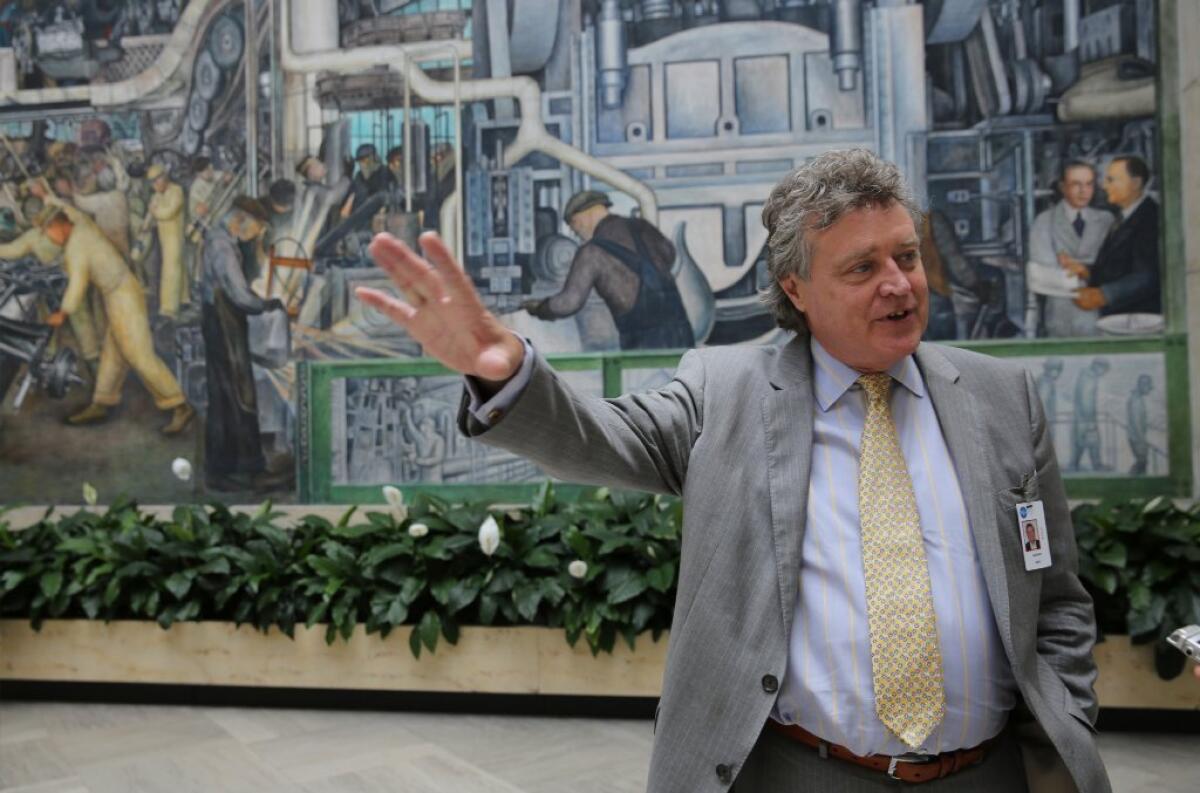Graham Beal to retire after guiding Detroit’s DIA through peril

- Share via
Graham Beal will retire in June after 16 years as director of the Detroit Institute of Arts, capped by his leadership as the art museum fought to preserve its masterpieces when they seemed in danger of being ransacked to appease creditors in the city’s epic bankruptcy.
The bankruptcy was settled in November without any of the city-owned DIA’s art having been touched. The collection had come into play almost from the moment Detroit declared bankruptcy in the spring of 2013.
Beal, 67, who was director of the Los Angeles County Museum of Art for three years before jumping to the DIA in 1999, became the point man for the Detroit museum’s resistance to creditors’ insistence that it be forced to sell art treasures.
The museum’s position boiled down to more politely stated ways of saying “over our dead bodies” and “we’ll see you in court.”
The collection includes pieces by Rembrandt, Van Gogh, Picasso and Peter Breugel the Elder’s “The Wedding Dance.”
Creditors and a state-appointed overseer for Detroit’s municipal finances hired appraisers to determine how much the city might realize from selling off the most valuable holdings of the DIA, which, like LACMA, is an “encyclopedic” museum that collects and exhibits art from all times and places.
Instead, the DIA and its supporters in the Michigan legislature and several major charitable foundations in effect ransomed the art collection by cobbling together what became known as the “Grand Bargain.” It called for raising $800 million for the city, including $195 million from the state, with the money going to threatened pension funds for city employees.
The DIA announced this week that it had finished raising its $100 million share of the “Grand Bargain.” Under the agreement, the museum and its collection no longer will be owned by the city, but by the private, nonprofit entity that’s headed by the museum director and board of trustees. The DIA has announced a $275-million campaign to increase its endowment and stabilize its long-term finances.
Beal told the Detroit Free Press that his decision to retire was not driven by the bankruptcy tumult, but that he did put off the announcement until the DIA was no longer in jeopardy.
“It would have been a distraction,” he said. “I’ve done a lot, and we’ve achieved a lot ... and I’m turning 68. I think it’s time, even though the work is not all complete in terms of building the endowment.”
Also contributing to the DIA’s financial stability is another key success of Beal’s tenure – a 2012 ballot initiative victory in which voters in three counties that include Detroit and its suburbs agreed to increase property taxes for 20 years, yielding about $23 million a year for museum operations. Officials in the counties had vowed to rescind the tax funding if bankruptcy creditors succeeded in forcing a sale of the DIA’s art.
The special funding currently covers about 70% of its annual expenses.
Beal also oversaw fundraising and construction for a $158-million museum renovation completed in 2007.
Beal was at LACMA from 1996 to 1999. Highlights of his LACMA tenure include “Van Gogh’s Van Goghs,” a blockbuster 1999 touring exhibition of paintings from the Van Gogh Museum in Amsterdam that drew huge crowds and earned LACMA more than $7 million, and the acquisition in 1997 of a major collection of 20th century Mexican art.
Known as the Lewin Collection, the donated art trove featured more than 1,800 works by Diego Rivera, Frida Kahlo, Rufino Tamayo, Jose Clemente Orozco and others, providing LACMA with its first extensive holdings of art from a country and period crucially bound up with Los Angeles history and culture.
Follow @boehmm of the LA Times for arts news and features
More to Read
The biggest entertainment stories
Get our big stories about Hollywood, film, television, music, arts, culture and more right in your inbox as soon as they publish.
You may occasionally receive promotional content from the Los Angeles Times.











